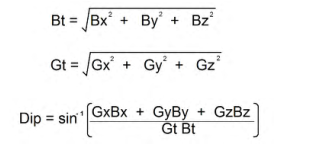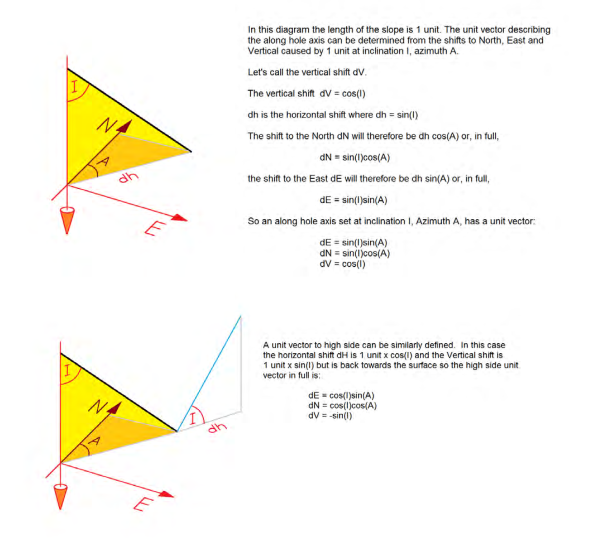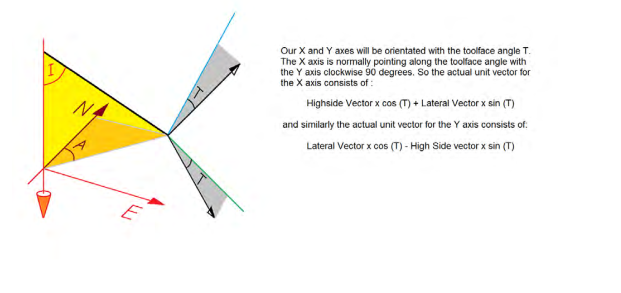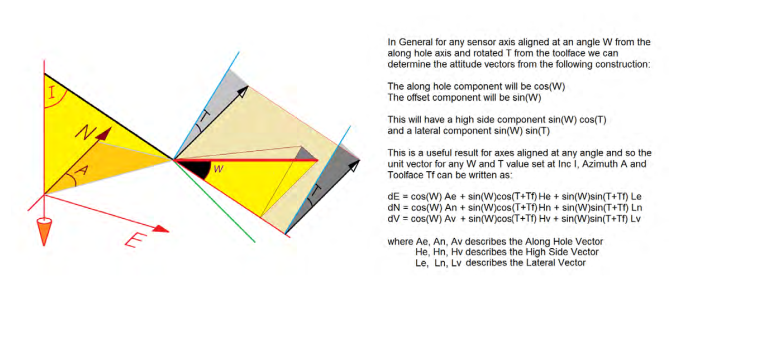D1 – Equivalent Radius Formula
A dogleg severity can be converted to an equivalent radius using the following. If using degs / 100ft use the top formula and if using degs/30m use the bottom formula.

D2 – TVD and Step Out change When Building Angle

D3 – Minimum Curvature


In the special case where I1 and I2 are the same and A1 and A2 are also the same, you only need to calculate S as 0.5 x dM where dM is the measured depth change from point 1 to point 2.
Step by Step
1. dN1 = sin(I1)cos(A1)
2. dE1 = sin(I1)sin(A1)
3. dV1 = cos(I1)
4. dN2 = sin(I2)cos(A2)
5. dE2 = sin(I2)sin(A2)
6. dV2 = cos(I2)
7. Theta = Acos(dN1dN2+dE1dE2+dV1dV2)
8. dM = (Md2 – Md1)
9. R = dM/Theta
10. If Theta = 0 then S = .5*dM
11. If Theta >0 then S = Rtan(Theta/2)
12. dNorth = s(dN1+dN2)
13. dEast = s(dE1+dE2)
14. dTVD = s(dV1+dV2)
D4 – MWD QC Checks
These formulas can be used to calculate Btotal, Gtotal and Dip from a long survey

1. Inclination and Azimuth calculation from raw data

D5 – Useful MWD Vectors





D6 – Short Collar Correction
This is the most common formula for calculating a synthetic Bz value for substation into the azimuth formula.

This can be unstable in areas where the z axis value is small. This is any time when the well attitude is close to a right angle with the Earth’s Magnetic Field.
An alternative sometimes used is to derive the synthetic Bz from the Dip Angle but Dip is not often known to a high degree of accuracy and this formula will also fail when Gz goes to zero (i.e. horizontal).


D7 – Multi Station Analysis
In theory, we only need on magnetometer to determine the azimuth albeit with an east or west ambiguity. So we may not know what side of East or West we are but we can come up with an azimuth 0 to 180. However, we have 3 magnetometers and so, not only is the ambiguity resolved but we have redundancy on the measurement. You can imagine that we have a slight disagreement between the 3 sensors and also a disagreement with the dip and field strength of the background field. These disagreements are due to magnetic interference on each axis. If we found the right scale and bias corrections to clean out the interference, the three sensors would all agree with each other and agree with the Bt and Dip of the known background field. Now let’s take a look at the vectors derived above that describe the sensor axes for a given inclination, azimuth and toolface.

We typically have 3 axes as follows:
X axis T = 0 : W =90
Y axis T = 90 : W = 90
Z axis T = 0 : W = 0
If we then set up the following step by step procedure, we can derive corrections to Bx, By and Bz to
minimize the disagreements all the way down the BHA run.
D8 – Multi Station Procedure
1. Use the Gx, Gy, Gz, Bx, By, Bz to calculate the best fit inclination, azimuth and instrument toolface using the standard formulae.
2. Identify and remove any observations that produce highly inconsistent Bt, Gt or Dip values from those around it. (Note inconsistent with the rest of the data NOT with the background field values.
We are expecting to fail basic QC against the background field when we know there is magnetic interference to be found)
3. For each axis calculate the unit vectors describing their attitude in N,E and Vertical
4. For each magnetometer calculate what you would expect a clean reading to be by taking the dot product with the earth’s magnetic field vector.
5. Define an ‘error’ as the difference between the clean value and the observed value.
6. For all surveys so far add up the sum of the squares of the errors.
7. See if the Errors are improved with a +/- 5 nT bias on Bz and if so apply it until there is no further improvement.
8. Repeat for By and Bx
9. See if the errors are improved by swapping bias errors with some scale error on Bz
10. Repeat for Bx and By
11. Once the minimum error cannot be improved, you have found the best corrections. It is unusual for good quality data to drop into a ‘local minimum’ that is not the correct result but a good test is to
start with large values and see if the final set is the same.


Post your comment on this topic.